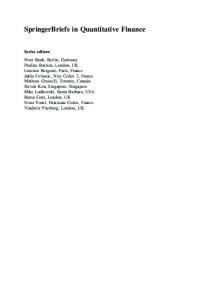Partial Derivatives
THIS book, like its predecessors in the same series, is in tended primarily to serve the needs of the university student in the physical sciences. However, it begins where a really elementary treatment of the differential calculus (e. g. , Dif ferential
- PDF / 4,258,151 Bytes
- 64 Pages / 360 x 575.43 pts Page_size
- 113 Downloads / 497 Views
SOp net
PARTIAL DERIVATIVES
LIBRARY OF MATHEMATICS edited by
WALTER LEDERMANN D.Sc., Ph.D., F.R.S.Ed., Professor of Mathematics, University of Sussex
Complex Numbers Differential Calculus Differential Geometry Electrical and Mechanical Oscillations Elementary Differential Equations and Operators Fourier and Laplace Transforms Fourier Series Integral Calculus Linear Equations Multiple Integrals Numerical Approximation Partial Derivatives Principles of Dynamics Probability Theory Sequences and Series Sets and Groups Solid Geometry Solutions of Laplace's Equation Vibrating Strings Vibrating Systems
W. Ledermann P. J. Hilton K. L. Wardle D. S. Jones G. E. H. Reuter P. D. Robinson 1. N. Sneddon W. Ledermann P. M. Cohn W. Ledermann B. R. Morton P. J. Hilton M. B. Glauert A. M. Arthurs J. A. Green J. A. Green P. M. Cohn D. R. Bland D. R. Bland R. F. Chisnell
PARTIAL DERIVATIVES BY
P.
J. HILTON
ROUTLEDGE & KEGAN PAUL LTD LONDON AND BOSTON
First published I960 in Great Britain by Routledge & Kegan Paul Ltd Broadway House, 68-74 Carter Lane London, EC4 V SEL and 9 Park Street, Boston, Mass. 02I08 Second impression I963 Third impression I96S Fourth impression I969 Fifth impression I973 © P. J. Hilton I960 No part 01 this book may be reproduced in any form without permission from the publisher, except for the quotation 01 brief passages in criticism
ISBN 978-0-7100-4347-4 ISBN 978-94-011-6089-6 (eBook) DOI 10.1 007/ 978-94-011-6089-6
Preface THIS book, like its predecessors in the same series, is intended primarily to serve the needs of the university student in the physical sciences. However, it begins where a really elementary treatment of the differential calculus (e.g., Differential Calculus,t in this series) leaves off. The study of physical phenomena inevitably leads to the consideration of functions of more than one variable and their rates of change; the same is also true of the study of statistics, economics, and sociology. The mathematical ideas involved are described in this book, and only the student familiar with the corresponding ideas for functions of a single variable should attempt to understand the extension of the method of the differential calculus to several variables. The reader should also be warned that, with the deeper penetration into the subject which is required in studying functions of more than one variable, the mathematical arguments involved also take on a more sophisticated aspect. It should be emphasized that the basic ideas do not differ at all from those described in DC, but they are manipulated with greater dexterity in situations in which they are, perhaps, intuitively not so obvious. This remark may not console the reader bogged down in a difficult proof; but it may well happen (as so often in studying mathematics) that the reader will be given insight into the structure of a proof by following the examples provided and attempting the exercises. Thus the proofs of the theorems should not be the reader's prime concern on first reading.
The University, Birmingham
P.
t Re
Data Loading...











